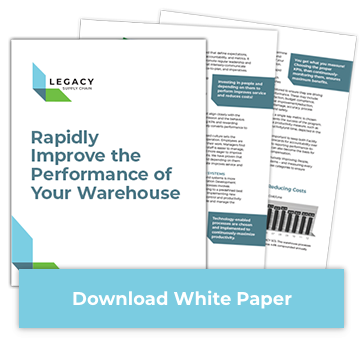Is Your Warehouse Management System Breaking Your Bottom Line?

A Warehouse Management System (WMS) is crucial to a supply chain’s bottom line. Underperforming systems can break it, while a Tier 1 platform can make it. Today’s WMS technology provides visibility and management of product inventory, and also extends into warehouse labor, space utilization, workflows, equipment requirements, and even accounting.
Here’s how a Warehouse Management System can make or break your bottom line:
RFID/Location tracking
One of the most fundamental aspects of WMS is tracking the physical movement of products into and out of the warehouse. RF, or RFID (Radio-Frequency Identification) technology scans and enters inventory into the system, and WMS keeps track of its various destinations until final fulfillment to your consumers.
MAKE: Accuracy and real-time visibility of products, efficiency through automated data collection
BREAK: Manual data capture and reliance on physical location of products
Inventory Management
Above and beyond tracking location, a robust WMS will track each type of product to an SKU or even serial number level, its shelf cycle, average time to ship, velocity, etc. Inventory and order management integration within the software allows for real-time analysis and provides an accurate picture of the state of the warehouse product through custom reports and live dashboards.
MAKE: Automated reports and stats based on real-time, robust data
BREAK: Disconnected tracking and reporting modules and spreadsheets
Customer Service
Being able to respond to and fulfill orders quickly and accurately ultimately drives more sales. A good WMS will integrate with a client’s order management or ERP platform, and will provide product visibility through an online customer facing portal.
MAKE: integrated PO management status visibility
BREAK: Inaccurate orders, lost products, inability to check real-time status, resulting in loss of business and damaged reputation
Planning and Forecasting
Integrated reporting and analysis from inventory and order management data can be used to forecast orders, quantities, and anticipate peak times. Knowing product cycles allows you to maintain optimal levels of inventory and streamline shipping.
MAKE: Product flow is smooth, inventory costs are maintained and space is used efficiently
BREAK: Unused products take up space in the warehouse, and sales are lost due to out-of-stock items.
Invoicing and Records Management
Many modern WMSs are able to integrate with accounting systems to automate labor tracking and invoicing processes. Having detailed transactional data integrated into billing functions saves duplicitous work and decreases errors.
MAKE: Accurate and timely invoicing, labor, and supply records
BREAK: Lengthy processing time and inaccurate or delayed invoicing
Automatic Notices
Most big-box retailers have strict shipping and receiving guidelines. Avoid unnecessary chargebacks using Electronic Data Interchange (EDI), including Advance Shipment Notifications (ASNs). A strong WMS platform will be equipped to use ASNs and other automated electronic notifications to stay in compliance with retail stores.
MAKE: Automated electronic communications keep products moving through the supply chain
BREAK: Costly returns due to inefficient communications, missed delivery windows and unapproved shipments
These are a few best-in class capabilities that should be involved in the execution of a strong supply chain. Contact LEGACY to learn more about improving your supply chain and increasing performance by utilizing Tier 1 warehouse management system technology.
Get Insights. Stay Ahead.
Get the latest news and insights via email on warehouse improvement, transportation optimization, labor strikes and international shipping rate changes.Popular Posts
Search Posts
-
2024 Q1 Freight Landscape: Trends, Challenges, and Predictions
As the first quarter of 2024 comes to an end, here are some observations over the past few months as well as predictions about the trucking...
+ Read more -
Baltimore Bridge Impact Assessment – Update
Following the recent Baltimore Bridge collapse and subsequent port closures, we want to keep our customers informed about the situation and...
+ Read more -
Global Momentum Builds for Charge on Global Shipping Sector’s CO2 Emissions
A growing coalition of 47 countries, including key players like the European Union, Canada, Japan, and various Pacific Island nations, is...
+ Read more










